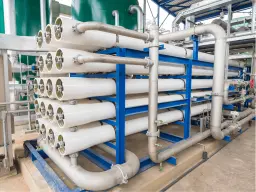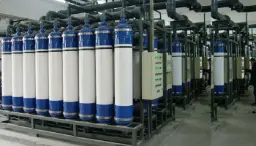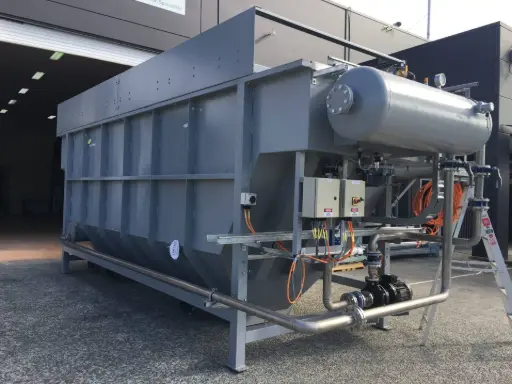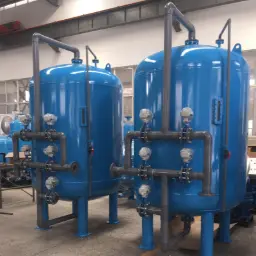Ore Beneficiation
Efficient water management sits at the heart of modern ore beneficiation, because every crushing, grinding, classification, flotation and dewatering stage relies on carefully conditioned process water to separate valuable minerals from gangue. In the mining and metallurgy value chain, ore beneficiation describes the collection of physical and chemical unit operations that upgrade run-of-mine ore into a saleable concentrate while producing a stable tailings stream. The term covers comminution, sizing, gravity separation, magnetic separation, froth flotation and thickening, yet each of these steps introduces suspended solids, residual reagents and dissolved metals into the circulating water loop. Engineers therefore ask, “What is ore beneficiation?” not only in terms of metallurgical yield but also in terms of water quality stewardship, because a plant cannot achieve target recovery rates if its process water is turbid, scaling or toxic to flotation reagents. Energy-intensive mills consume thousands of cubic metres of make-up water per day, so uncontrolled losses drive operating cost and environmental risk. Rising regulatory pressure around zero-liquid-discharge, plus stakeholder scrutiny of tailings dam integrity, makes water treatment integral to both permitting and corporate sustainability reporting. By integrating clarification, filtration, ion exchange, membrane treatment and smart monitoring into the beneficiation circuit, operators cut reagent consumption, extend equipment life and harvest high-quality water for reuse in grinding and flotation. They also reduce freshwater abstraction, a critical metric for mines located in arid basins or sharing watersheds with agricultural users. Finally, optimized water treatment underpins safe tailings storage, because clarified overflow contains fewer fines that could compromise dam walls, and detoxified water meets discharge limits without costly fines or unplanned shutdowns.
The interplay between mineralogy, reagent chemistry and hydrodynamics makes water treatment design site-specific, yet the fundamentals remain universal. Suspended mineral slimes raise slurry viscosity and can smother bubble surfaces, reducing flotation kinetics. Dissolved calcium and magnesium contribute to scaling in heat exchangers and pipelines, forcing unscheduled cleaning. Residual xanthates, dithiophosphates or frothers create toxicological hazards for downstream biota, so their removal is mandatory under most national mining standards. Elevated chloride may accelerate corrosion in grinding mills and high-pressure pumps, while high sulfate concentrations limit process water reuse, especially in lime-controlled alkaline circuits. Because beneficiation circuits recirculate water many times, contaminants tend to concentrate, making periodic bleed-and-feed strategies inadequate. Instead, dedicated treatment skids recover reagents, precipitate heavy metals, and polish permeate before it returns to the plant header or is discharged to surface water. Digital twins and inline sensors now predict when water quality drifts toward process limits, triggering real-time dosing changes rather than reactive lab sampling. In this way, water treatment moves from a peripheral utility to a strategic lever that maximises overall equipment effectiveness, lowers scope-1 and scope-2 emissions, and strengthens the social licence to operate for mining companies competing for scarce water rights.
Water Treatment Systems Used

Reverse Osmosis
Removes dissolved salts and sulfates to control scaling and corrosion, recovering up to 75 % of the feed while lowering specific energy consumption through pressure energy recovery.

Ultrafiltration
Provides robust separation of <0.1 µm particles and emulsified organics at high temperature and extreme pH, extending the service interval even under abrasive slurry carry-over.

Dissolved Air Flotation (DAF)
Captures residual reagent droplets and ultrafine hydrophobic particles using aerated micro-bubbles, thus protecting downstream membranes from fouling.

Ion Exchange
Target dissolved heavy metals such as Cu²⁺, Zn²⁺ and Ni²⁺ that escape precipitation, polishing water to below discharge limits and enabling closed-loop reuse.
These systems act in series and occasionally in parallel to deliver a multi-barrier treatment philosophy that safeguards both product quality and environmental compliance. Clarifiers and paste thickeners reduce the solids burden early, meaning fewer particles reach membrane surfaces. DAF then strips residual organics so they do not foul UF pores, while ceramic membranes provide a rugged cut-off step before delicate RO spirals. Ion-exchange columns handle the elusive dissolved metals that chemical precipitation cannot economically remove, ensuring permeate meets stringent legislation for aquatic toxicity. Finally, the RO train trims conductivity to levels acceptable for high-efficiency grinding and flotation chemistry. Together, these technologies complete the water loop within an ore beneficiation plant, securing operational continuity, lowering make-up water demand and shrinking the site’s hydrological footprint.
Key Water-Quality Parameters Monitored
Understanding water chemistry trends is the first defence against process upsets, so engineers install a comprehensive analytics suite across the beneficiation circuit. Operators monitor parameters that influence both metallurgical performance and equipment integrity, recognising that a deviation in pH, oxidation-reduction potential or suspended solids can ripple through multiple unit operations. Inline turbidity sensors warn when fine grind overflow breaks through thickener underflow control, long before operators notice a drop in concentrate grade. Continuous conductivity readings track soluble salt accumulation from recycling, flagging when RO permeate blending ratios need adjustment. Dissolved oxygen probes reveal the effectiveness of reagent scavenging systems, because excessive oxygen can lead to unwanted oxidation of sulfide minerals and consequent flotation depression. Total organic carbon (TOC) analysers quantify residual collectors and frothers, helping environmental teams prove compliance with mine effluent permits and enabling process teams to reclaim unused reagents. Real-time heavy metal analysers based on X-ray fluorescence now sit beside traditional wet-chemistry labs, providing near-instant feedback on copper or arsenic in treated water.
Not every parameter receives the same control method. Some, like pH, lend themselves to automated feedback loops that regulate lime or sulfuric acid dosing within seconds. Others, such as scaling potential expressed as Langelier Saturation Index, require composite calculations derived from calcium, alkalinity, temperature and pH readings. Turbidity alarms initiate polymer coagulant boosting in clarifiers, while a rise in TOC may trigger fresh air injection to the DAF. Conductivity targets link directly to RO permeate recycle ratios, and when sulfate approaches saturation in evaporation ponds, brine bleed streams divert to crystalliser systems. By plotting these variables on a common data historian, engineers correlate water-quality excursions with plant events like cyclone bypass or reagent batch changes, shortening root-cause investigation time. The table below summarises typical operational ranges and primary mitigation strategies for the most critical parameters in ore beneficiation water treatment.
| Parameter | Typical Range | Control Method |
|---|---|---|
| pH | 7.0 – 9.0 (alkaline flotation) | Automated lime or acid dosing skid |
| Turbidity (NTU) | < 50 in recycled process water | Polymer-assisted clarification / UF |
| Conductivity (µS cm-¹) | 300 – 2 000 depending on ore | RO permeate blending and bleed stream |
| TOC (mg L-¹) | < 10 prior to discharge | DAF with coagulant aid, carbon filter |
| Dissolved Heavy Metals (mg L-¹) | Cu < 0.2, Zn < 0.5, As < 0.05 | Hydroxide precipitation, ion-exchange |
| Sulfate (mg L-¹) | < 1 000 for recycle, < 250 discharge | Gypsum crystalliser, RO-NF hybrid |
| Iron (mg L-¹) | < 3 for corrosion control | Oxidation-filtration, pH adjustment |
| Scaling Index (LSI) | –0.5 – +0.5 | RO antiscalant, acid dose |
| Residual Xanthate (mg L-¹) | < 0.3 | Advanced oxidation (UV-H₂O₂) |
Design & Implementation Considerations
Designing a water treatment train for ore beneficiation starts with a holistic mass balance that maps every unit operation, bleed stream and evaporation loss across the mine-to-mill interface. Process engineers first survey raw water sources, whether river diversion, pit dewatering or municipal supply, and establish the make-up water chemistry envelope. They then perform bench and pilot tests to confirm flocculant dosages, membrane flux rates and ion-exchange loading capacities under real slurry conditions, because synthetic lab water rarely mimics the shear-induced fines and shear-degraded reagents present in plant loops. Capital planners weigh modular skid designs against stick-built concrete basins, recognising that remote mining camps often face skilled labour shortages and compressed mobilisation windows. Harsh winter climates dictate insulated enclosures, heat tracing and glycol loops, while tropical sites prioritise cyclone-rated structures and corrosion-resistant alloys such as duplex stainless or FRP. Electrical engineers size variable-frequency drives on thickeners and pumps for energy optimisation, reflecting the growing push for Scope-2 emission reductions using renewable micro-grids. Instrument specialists integrate radar level sensors, magnetic flow meters and optical spectrometers into a unified SCADA that feeds the mine’s digital twin, enabling predictive maintenance via machine-learning models trained on historical water-quality data.
Chemical selection requires equal care. While high-molecular-weight polyacrylamide flocculants excel at settling ultrafines, they introduce residual monomer that downstream discharge permits may restrict. Lime dosing raises pH for sulfide depression but raises scaling risk in heat exchangers, so design teams often install dual chemical header lines to toggle between lime and caustic soda depending on seasonal temperature swings. In chloride-rich ores, titanium or rubber-lined pipework prevents under-deposit pitting that would otherwise plague mild steel. Engineers size RO arrays for 75 % recovery to balance water efficiency with antiscalant cost, and specify energy-recovery turbines to capture waste pressure from concentrate streams, shaving 2-3 kWh m-³ off the specific energy consumption. They also provide bypass lines to maintain flotation feed continuity during membrane cleaning. Lastly, control philosophy favours cascade interlocks: if UF trans-membrane pressure exceeds setpoint, backwash triggers; if backwash fails, feed pumps ramp down and clarifier recycle loops open, ensuring no single failure floods the plant.
Operation & Maintenance
Long-term success in beneficiation water treatment depends on disciplined operation and proactive maintenance rather than initial design alone. Experienced operators treat water skids as integral process units rather than auxiliary utilities, calibrating sensors daily and verifying lab grab samples weekly to catch drift in optical or electrochemical probes. Membrane teams track specific flux decline curves to schedule clean-in-place (CIP) cycles before irreversible fouling sets in, rotating between acidic and caustic solutions tailored to the dominant foulant species. Paste thickener rakes demand regular torque monitoring; a sudden rise may indicate bed compaction that compromises underflow density, prompting immediate polymer dose adjustment. Ion-exchange systems follow exhaustion curves based on real-time breakthrough detection using online metal analysers, enabling bed regeneration with minimal chemical waste.
Predictive analytics converts historian data into actionable maintenance plans. Vibration sensors on high-pressure pumps feed into cloud-based models that flag bearing wear weeks before catastrophic failure, while acoustic sensors on lamella clarifiers detect plate fouling patterns invisible to visual inspection. Spare-parts logistics now link enterprise resource planning (ERP) to vendor inventory via the industrial internet of things, ensuring critical seals, couplings and instrument boards arrive just in time even to remote mountaintop mines. Operators also practice seasonal operating modes: winterising lines with propylene glycol fill, raising DAF dissolved air saturation pressure to compensate for lower solubility, and scheduling major membrane overhauls during planned crusher shutdowns. Water-treatment KPIs tie into site-wide dashboards, showing recovery rate, make-up water reduction and chemical cost per tonne of ore, fostering a culture where metallurgists, environmental scientists and maintenance crews collaborate rather than operate in silos.
Challenges & Solutions
Ore beneficiation water circuits face numerous challenges, starting with variability. Ore bodies transition from oxide to sulfide, altering reagent suites, pH and redox conditions within months, so treatment systems must handle shock loads without breaching permit limits. Tailings dam safety regulations grow ever stricter after high-profile failures, pushing operators toward paste or dry-stacked tailings that require higher-density thickening and thus more sophisticated water recovery. Abrasive slurries scour pumps and damage membrane housings, inflating maintenance budgets. Climate change introduces both flood risk and drought, meaning a plant might battle stormwater dilution in one season and water scarcity in the next.
Solutions revolve around flexibility. Skid-mounted modular units allow rapid scaling or relocation, while variable chemistry dosing skids adapt coagulant blend ratios on the fly. Ceramic membranes withstand abrasive fines far better than polymeric analogues, and advanced antiscalants extend RO run times even with high silica or sulfate feed. Paste thickeners with high-efficiency rake drives generate stackable tailings, cutting water lock-up and dam footprint. Machine-learning-driven predictive control stabilises pH and redox before they drift, reducing reagent consumption by 10-15 %. Remote mines adopt solar-powered microgrids feeding energy-recovery devices to curb operating cost and improve ESG scores. When drought threatens water intake quotas, mines retrofit vacuum belt filters to capture water locked in tailings cakes, then polish filtrate via UF-RO for direct process reuse.
Advantages & Disadvantages
The water-treatment approach described delivers multiple performance, environmental and economic benefits. Chief among these is reduced make-up water demand, often by 40 % or more compared with conventional bleed-and-feed circuits, translating into lower raw-water fees and greater security of supply in arid regions. Cleaner process water improves reagent selectivity, raising concentrate grade and recovery, while lower suspended solids lessen pump and pipe erosion, extending asset life. Compliance risk drops because discharge consistently meets pH, metal and toxicity criteria, avoiding fines and reputational damage. Furthermore, energy-recovery devices and smart dosing cut greenhouse-gas intensity, supporting mine-wide net-zero commitments.
Trade-offs exist. Capital cost rises due to membranes, automation and specialised alloys, which may strain capex budgets on smaller deposits. Ongoing maintenance of sensors, membranes and high-pressure pumps demands skilled labour that remote regions lack. Concentrated brine streams from RO require disposal or further treatment, introducing complexity. Finally, over-treating water where regulations are lenient could yield diminishing returns, so engineering teams must balance performance goals with total cost of ownership.
| Aspect | Advantages | Disadvantages |
|---|---|---|
| Water Consumption | Up to 40 % reduction through recycle and recovery | High RO reject volume requires management |
| Metallurgical Performance | Higher concentrate grade, improved recovery | Potential chemistry upset if treatment overdoses lime or flocculant |
| Environmental Compliance | Consistent discharge within metal and toxicity limits | Stricter monitoring and reporting obligations |
| Operational Reliability | Less scaling, corrosion and pump wear | Additional equipment increases failure points |
| Sustainability Metrics | Lower Scope-2 energy via energy-recovery turbines | Embodied carbon in high-alloy steel and membranes |
Frequently Asked Questions
Water-treatment engineers, plant managers and environmental officers routinely pose similar questions when planning or running beneficiation circuits, because the stakes involve both metallurgical profitability and social licence to operate. They want to know how often membranes foul with ultra-fine gangue, whether lime dosing can be reduced without harming flotation pH, and how selective ion-exchange compares to high-density sludge precipitation for metal polishing. Regulatory teams ask how to demonstrate continuous compliance when online metal analysers drift, while maintenance supervisors struggle with sourcing ceramic UF elements in remote regions. Investor relations departments meanwhile look for credible metrics that tie water-savings projects to ESG reporting frameworks. Because these questions arise at feasibility study, detailed engineering and operational phases, providing clear answers accelerates decision-making and avoids costly redesigns. Below is a consolidated collection of the most frequent queries along with concise, technically grounded answers.
-
How often must ceramic UF membranes be chemically cleaned in a copper concentrator?
Most operations schedule CIP every 4-6 weeks, but sites with high clay content may clean bi-weekly; flux trend monitoring determines the exact interval. -
Can we eliminate lime dosing if RO permeate constitutes the bulk of flotation make-up water?
Not entirely; while lower hardness helps, pH control to 8-9 for sulfide flotation still needs lime or caustic, albeit at reduced rates. -
What disposal options exist for RO brine in land-locked mines?
Common solutions include evaporation ponds with spray-enhanced drift, zero-liquid-discharge crystallisers, or blending brine into paste tailings for geochemical stability. -
Do ion-exchange resins foul with xanthates or frothers?
Modern chelating resins resist organic fouling, yet periodic backwash with dilute caustic and surfactant is recommended to maintain capacity. -
How does high chloride in process water affect ball-mill liner life?
Chloride accelerates pitting corrosion on carbon steel; switching to duplex stainless or rubber linings, and controlling chloride via RO, extends liner life by 30-40 %. -
What is the payback period for installing energy-recovery turbines on RO concentrate lines?
Depending on local electricity price, payback ranges from 1.5 to 3 years, with savings of 2–3 kWh per cubic metre of permeate produced. -
Can advanced oxidation remove residual cyanide in gold-ore beneficiation water?
Yes, UV-hydrogen peroxide or ozone systems achieve > 99 % destruction, enabling safe discharge or recycle, but dose control is critical to avoid excess peroxide. -
Will paste thickening increase flocculant consumption compared with conventional thickeners?
Typically yes, by 10-20 %, because higher underflow density demands stronger floc formation; however, water recovery gains often offset the added chemical cost. -
How reliable are online X-ray fluorescence metal analysers for real-time compliance?
Calibration with matrix-matched standards every 48 hours keeps drift below ±5 %, sufficient for most permit thresholds; redundancy with grab-sample labs remains best practice. -
Is selective precipitation a viable alternative to ion-exchange for copper removal?
At pH > 9 with controlled sulfide addition, copper precipitates effectively, but the resulting sludge complicates dewatering; ion-exchange offers a drier, more compact waste stream.